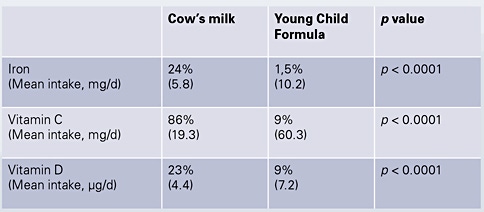Milk as a Carrier of Fortification
Key Messages
- There are good data to show that preschool children, especially those in the 1- to 3-year age bracket, are at risk of inadequate intakes of a number of important vitamins and minerals, notably iron and vitamin D
- Ultimately, nutritional education and securing better supply and availability of appropriate foods should address this important issue
- Nevertheless, until that can be achieved, there is good evidence to show that fortified milk, including young child formulas, can make a significant contribution to an appropriate nutrient intake at this important time in a child’s growth and development
Children aged between about 1 and 3 years are undergoing a significant period of nutritional transition from a milk-based diet, be that breast milk or an appropriate infant formula, to the consumption of an increasing amount and variety of family foods. This period is, however, a time when many children are at risk of inadequate nutrient supply especially in developing countries and disadvantaged populations in other countries. Moreover, neophobia (i.e., hesitancy to try new foods) and/or “picky eating” are also common at this time [1].
Young child formulas (YCF) have been marketed since around 1990 and are often seen as a solution to preventing inadequate nutrient supply in such children. The need for YCF is not universally accepted, as it is believed by many that the nutritional needs of children aged 1 to 3 years can be easily covered by a “balanced diet,” at no extra financial cost to families, and in an ideal world, this would be the case. Nevertheless, a recent review assessed the literature for available evidence of dietary nutrient intakes relative to reference nutrient intake across the globe [2]. Twenty-three publications from 19 different countries, including both developed and developing countries, met the review criteria. The authors concluded that many nutrients were often limited in many children, from many countries, notably vitamins A, D, B12, and C, folate, calcium, zinc, iron, iodine, and docosa-hexaenoic acid.
Matsuyama et al. [3] undertook a systematic review and meta-analysis of randomised controlled trials of what they referred to as “fortified milks,” which included YCF, against control milks, which was often standard cow’s milk. Fifteen articles sourced from 5 major international databases met the eligibility criteria that included that the population studied be otherwise healthy children aged between 6 and 47 months and that outcomes were growth parameters and biochemical markers. The use of fortified milk compared with control milk had a small nonsignificant effect on body weight gain over the study period (mean difference = 0.17 kg; 95% CI: 0.02–0.31 kg). However, it is noteworthy that the risk of anaemia was reduced in the fortified milk groups (OR = 0.32; 95% CI: 0.15–0.66). Iron deficiency, which can lead to anaemia, is reported as being the most common micronutrient deficiency in the world [4]; and so, clearly many young children are not receiving adequate amounts of dietary iron. As noted by Matsuyama et al. [3], efforts to raise public awareness of the importance of iron-rich complementary foods are essential. Nevertheless, availability of such foods can be scarce in some developing countries.

Very recently in 2018, the results of a randomised controlled trial of a YCF versus cow’s milk in Australia and New Zealand have been reported [5]. After having consumed either the YCF or cow’s milk for 12 months between the ages of 1 and 2 years, the YCF group had a lower total protein intake and higher iron, vitamin D, vitamin C, and zinc intake at 2 years of age with the differences for iron, vitamin C, and vitamin D reaching statistical signifi - cance. As reported by Suthutvoravut et al. [2], micronutrient deficiencies in young children are widespread, and whilst nutritional education and availability of appropriate foods are the key to overcoming this global problem, as was concluded by Matsuyama et al. [3], there is evidence that fortified milk can be effective also, under certain circumstances.